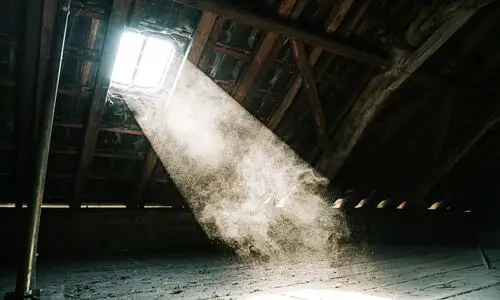Many people are well aware that mold and mildew can be detrimental to their health, and can also lead to damaged and stained walls and ceilings, but mold can be tricky stuff to determine as many strains can look very similar to household dust.
So how can you tell if what you are actually looking at is mold and not dust? What are the differences between the two, how can you test for mold and how can you prevent both in your home?
In this article, we answer all these questions and more, so for all you need to know about how to tell the difference between dust and mold, keep reading.

So, is it dust or mold?
Determining whether you are dealing with mold or dust plays a big part in the route you take to tackle it.
The problem is, it’s very easy to mistake mold for dust and dust for mold, as they can look very similar. This could lead to you thinking what you are dealing with is harmless dust, when in fact, you could be inhaling toxic spores if you were to wipe it away with a cloth and some polish.
To clear this up, I will list out the differing factors between the two so you can take a look and see which you have in your home so you can deal with it as safely and effectively as possible.
What does mold look like?
The good news is that upon close inspection, mold and mildew look really rather different from dust. They have different textures, smells and come in a variety of colors not often seen in dirt and grime. Let’s dive into some of these now so you know what to look out for.
Smell
The smell is one of the most powerful factors in determining whether you are dealing with fungal growth, as it is hard to mistake.
As soon as you open a door to a basement or attic, if there is mold growing, you will smell a musty odor that is sometimes compared to old socks or having an “earthy” scent.
It’s best not to go directly to the area you are uncertain of and take a deep inhalation as if it is mold, you could end up inhaling its spores. You really would know if the smell was present as soon as you were in a room, as it can be very pungent.
Color
As they age, molds can change color several times, this is largely dictated by the particular strain growing, the amount of sunlight it is exposed to, the level of humidity, and the sources of nutrition it has found.
They can be anything from dull colors like dark browns and blacks to vibrant blues, greens, turquoise, and even yellow, orange, or red in coloration. The most common strains found in the home are often referred to as “white mold”, and it is these that are usually mistaken for dust.
Environment
Mold and mildew is a living breathing organism, and therefore the environment inhabits plays a crucial role in its survival.
Mold may be complex in nature, but its needs are fairly basic, as long as it has a humidity level greater than 55%, a source of nutrients, oxygen, and a lack of sunlight, it will thrive.
This is why you will often find it growing in high-moisture areas such as bathrooms, kitchens, bedroom ceilings, attics, and basements.
What does dust look like?
I’m sure you’re well aware of what dust looks like, it’s that powdery stuff that accumulates in the corners of shelves, sideboards, and windowsills. However, some dust can look surprisingly similar to certain types of mold at first glance, especially damp dust which can sometimes look similar to harmful black mold.
So, let’s take a deep dive into some of the characteristics of mold to help you determine which it is you may be looking at.
Smell
Dust is a collection of many types of organic matter, combined together in powdered form after having died and dried out. Interestingly, between 20-50% of dust found within homes is made up of dead skin cells.
It’s for these reasons that you would expect dust to have a fairly strong smell, but in reality, as the organic materials have dried, the musty scent it creates is fairly mild.
Whilst mold also creates a “musty” scent, it is much more powerful and will be immediately apparent when walking into a room. Dust on the other hand is slightly more subtle.
Color
Dust is primarily grey or off-white in color, with exceptions coming from larger organic materials that have not completely deteriorated. Upon darker surfaces, it can appear lighter and almost white in color, whereas, on lighter surfaces, it shows darker grey specs.
When wiped with a light cloth, however, you will notice that it appears in the same grey, to dark grey/black color. This is, of course, a world away from the potentially vibrant orange, greens, and blues of mold and mildew.
Environment
The environment is where we begin to see a stark contrast between mold and dust. As stated, mold is a type of fungi, and so requires oxygen, nutrition, and hydration. Dust needs none of these, as it is comprised entirely of dead and dried organic matter.
It is, therefore, far more likely to be found accumulating in very dry and warm areas of a property after having been blown from outside a property, indoors via open windows and doors.
Does mold wipe off like dust?
Wiping mold away with a cloth may appear at first to tackle the problem, after all, the mold is now gone.
The issue with this is that even if you were to remove what you thought was the majority of fungi, many spores could remain on the surface you wiped, as well as be released into the air when the cloth disturbed the colony.
When these spores are released, they float through the air and settle on other surfaces within the room and the rest of your property, which makes wiping it away with a cloth an ineffective method, as well as potentially worsening the problem.
Can dust turn into mold?
Dust in itself will not turn into mold, as it is simply made up of dried organic matter. However, it does act as an excellent source of nutrition for fungi, as the dead skin cells that make up its majority (within a property), contain all the fats, minerals, and proteins it requires.
As mold can use dust as a source of nutrition, you often find it growing in dusty parts of a property, it is simply a matter of the dust when combined with a high-humidity environment creating the perfect breeding ground for fungi, which may give the impression the dust has turned into mold.
Are you having any health issues?
Another way to determine whether you have mold or dust in your home is to ascertain if any health issues you currently have may be put down to fungal growth or dust inhalation.
Both these scenarios can cause different health complaints, so I will list some of them now for comparison.
Health issues caused by dust
Exposure to dust particles mimics allergic reactions similar to hay fever, and can include the following symptoms:
- Stuffy nose
- Sneezing
- Coughing
- Irritated, watery eyes
- Skin irritation
- Breathing difficulties
If you were to inhale and subsequently “eat”, dust particles, they can cause some gastrointestinal discomfort and nausea in some cases.
Health issues caused by mold
Mold is really quite different from dust when either inhaled or ingested, as it has the potential to cause very serious health issues in some people, especially those with a suppressed immune system or severe allergies. This is due to the mycotoxins that some strains produce as a defense mechanism. Symptoms of mold inhalation and exposure include:
- Breathlessness
- Fatigue (in rare cases)
- Nausea
- Gastrointestinal discomfort
- Vomiting
- Skin irritation
- Headaches
- Wheezing
Molds that look like dust
As previously mentioned, many strains of fungi grow in vivid colors that make them easy to tell apart from dust, but there are some that grow in lighter shades, and when looked at from a distance, could be mistaken for dust particles.
The following is a list of mold strains that grow with light coloration (which are often labeled as “white mold”), and have a powdery texture that could be mistaken for dust.
- Aspergillus
- Penicillium
- Cladosporium
These are the three most commonly found strains growing in homes, but there could be several other potential strains including Mucor, Acremonium, and Aspergillus versicolor, but these are far less commonly sighted.
A simple test to determine mold from dust
The good news is, if you want to test if what you have spotted is dust or mold, there is a very quick and simple method you can use to have your answer in a matter of seconds.
Take a cotton swab (Q-tip), and dip it in household bleach. Gently dab the swab onto what you suspect could be mold and wait to see if there is any reaction. If it is in fact mold you have, it will begin to lighten in color, and dust, and will have little to no reaction at all.
How to prevent dust and mold
By reducing the amount of dust in your home, you will also be reducing the possibility of mold growth, as you are taking away its main source of nutrition.
To keep your house dust and mold-free, use the following tips.
- Keep windows and doors closed when possible
- Regularly dust countertops, window sills, and anywhere dust regularly accumulates
- Vacuum flooring weekly
- Declutter your property
- Groom pets on a regular basis
- Store fabric items away in containers
- Purchase a HEPA filter for your vacuum
- Consider an air purifier
These are just a few of the techniques you can use to reduce dust accumulation in a property, with the HEPA-filtered vacuum being one of the most powerful options. This type of vacuum is designed to collect small particles that form dust and cause allergic reactions in some, so to keep dust as low as possible, consider purchasing one of these.
Conclusion
Mold can indeed look like dust, however, upon closer inspection there are some subtle differences between the two. Mold is a breathing living organism, and dust is made up of dead and dried-up organic matter, (mostly skin cells in household dust).
A simple test using household bleach will determine whether you are dealing with dust or mold and the easiest way to prevent both is to regularly vacuum and dust window sills and flooring.

